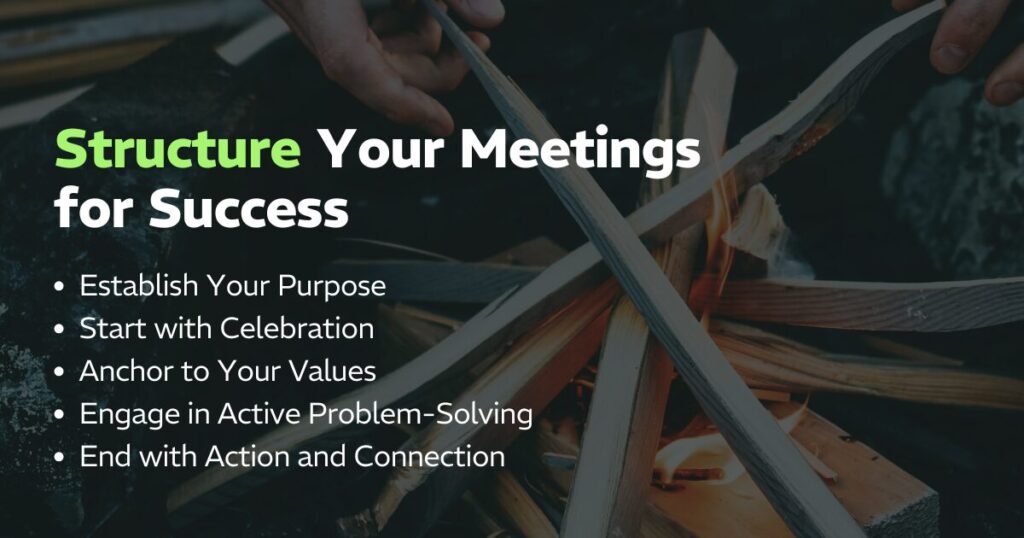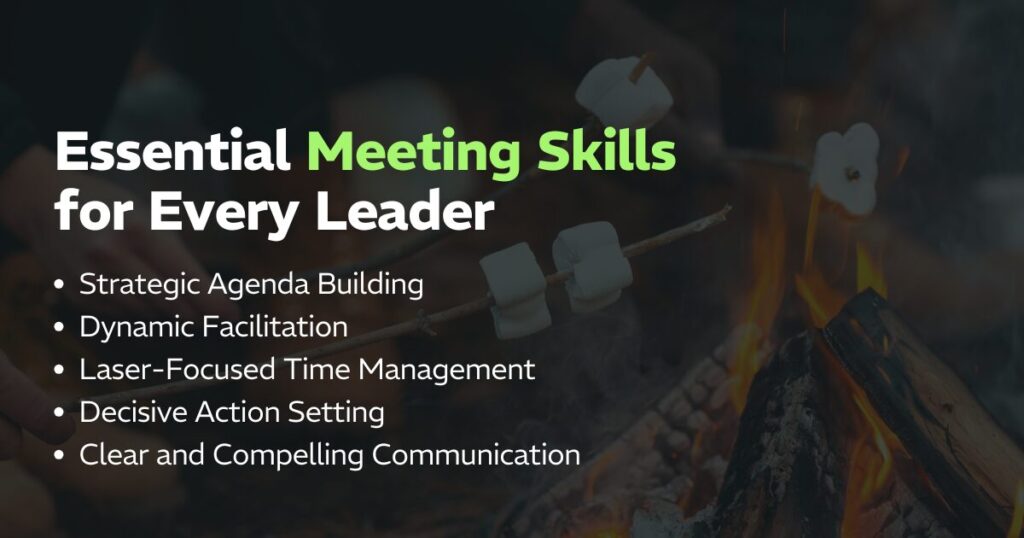“I was stuck in meetings.”
It’s the default answer for how senior leaders spend the majority of their time. But spending time in meetings — and not knowing how to run an effective meeting either — is wreaking havoc on organizational productivity.
That isn’t just my opinion: Atlassian recently surveyed 5,000 knowledge workers across four continents and their findings were eye-opening:
- 78% of respondents felt that the volume of meetings hinders their ability to complete their work efficiently.
- 54% of workers often leave meetings without a clear understanding of next steps or task ownership.
- 77% of those surveyed said they’re frequently in meetings that end in a decision to do one thing: schedule a follow-up meeting.
We can do so much better.
To be fair, meetings can serve a purpose — when they’re done well. They provide opportunities for collaboration, decision-making, and connection. But too often, they undermine job performance and morale instead of driving alignment and results.
Inspired by practices from leaders I admire, I wanted to share a few things I’ve learned about how to kick off and wrap up meetings in a way that keeps teams inspired and on track:
5 Types of Meetings and Their Purpose
Not all meetings are created equal. Understanding the types of meetings can help you tailor your approach:
- Production Meetings: Focused on immediate project deliverables and updates.
- Brainstorming Sessions: Creative, free-flow discussions to generate ideas.
- Strategy Meetings: High-level planning and decision-making.
- Virtual Meetings: Ensure remote participants feel included with clear agendas and engagement techniques.
- Recurring Meetings: Regularly scheduled check-ins require extra scrutiny to ensure they remain relevant.
Each type of meeting requires a different approach, but they all benefit from clear goals, preparation, and accountability.
Structure of Meetings: Planning for Success
An effective meeting follows a clear structure. Here’s a proven format to keep your team engaged and productive:
Establish Your Purpose
Every effective team meeting begins with a clear purpose. Before you schedule that recurring meeting, ask yourself:
- What is the goal of this meeting?
- What are the key points to discuss?
- What decisions need to be made?
Avoid vague objectives like “status updates,” “sharing information,” or “discussions.” Instead, define what success looks like and align the agenda accordingly. A concise agenda with specific agenda items sets the tone for a productive session.
What do you need to accomplish at this meeting? What are the decisions that need to be made? And what’s the shortest amount of time you need to make that happen? The arbitrary one-hour meeting assignment should evolve. We schedule them in 15-minute intervals because that’s way more efficient.
Start with Celebration
Begin by recognizing wins or highlighting success stories. Whether it’s a team achievement, a client milestone, or individual contributions, starting on a high note energizes the room and reinforces positive behaviors.
Anchor to Your Values
Tie the meeting to a core value like teamwork, innovation, or growth. Highlight someone who exemplifies that value to create alignment and inspiration. Don’t miss opportunities to include customer outcomes and testimonials. Afterall, that’s who we’re assembled to serve!
Engage in Active Problem-Solving
Use the middle portion of the meeting for brainstorming, collaboration, and tackling challenges. Ensure all meeting participants feel heard and that discussions remain focused on the agenda.
End with Action and Connection
Close by reflecting on key takeaways, expressing gratitude, and ensuring clarity on next steps. This builds accountability and leaves everyone feeling seen, understood, valued, and committed.
A successful meeting doesn’t just end; it concludes with clarity and connection. Recap key points, thank participants for their contributions, and confirm that everyone understands their next steps.
Use this three-question framework to guide your close:
- What do I want people to know?
- How do I want people to feel?
- What do I want people to do?
When you end meetings with purpose and gratitude, you foster accountability and strengthen team morale.

Manage Technology to Stay Focused
Distractions from devices can undermine even the best-planned meetings. Implementing a no-device policy can help ensure that team members remain present and engaged.
Laptops and phones often encourage multitasking. But research shows that multitasking significantly reduces productivity — and we’re actually terrible at it. As a meeting leader, set expectations upfront:
- No devices unless absolutely necessary.
- Encourage note-taking by designating a note taker instead of relying on individual participants to split their attention. (And yes, you can use AI for that.)
This policy might feel old-school, but it’s a simple way to improve meeting effectiveness.
Give the no-device policy a test. Encourage people to be present and engaged, and watch the productivity of meetings for your team improve dramatically.
Meeting Leadership Skills to Master
Effective team meetings isn’t just about keeping things on schedule—it’s about driving real impact. These essential skills are what separate great meeting leaders from the rest:
- Strategic Agenda Building: Crafting agendas that focus on what matters most and keep the team aligned on priorities.
- Dynamic Facilitation: Creating an environment where every voice is heard, ideas flow freely, and conversations stay balanced.
- Laser-Focused Time Management: Running meetings with precision, sticking to the plan, and pivoting when necessary to keep momentum.
- Decisive Action Setting: Turning talk into tangible next steps by clarifying decisions, assigning ownership, and setting deadlines.
- Clear and Compelling Communication: Guiding the team with confidence, clarity, and purpose to ensure everyone leaves the room on the same page.
These skills aren’t just about running smooth meetings—they’re about elevating team performance and making every minute count.

Addressing Common Meeting Pitfalls
Here are some of the most common issues in meetings and how to address them:
Lack of Preparation and Purpose
Meetings often fail because participants and team leaders aren’t prepared. Share pre-meeting materials and ensure everyone knows what’s expected. And if you can’t articulate the purpose of the meeting in one sentence, cancel it.
Overcrowded Agendas — and Conference Rooms
A key component of meeting management is ensuring that the right people are discussing the right topics. Large organizations should take a page from the Amazon playbook and roll with the two-pizza rule for meetings. That means not having more people in the room than could be fed by two pizzas. And make sure that those participants prioritize the most important agenda items and save less critical topics for separate discussions.
Also, it doesn’t hurt to serve actual pizza sometimes.
Poor Follow-Up
You spent the time meeting. Now it’s time to take action. Ensure all action items are documented and shared immediately after the meeting.
Raise the Bar on Your Meetings
Meetings don’t have to be a waste of time. By prioritizing preparation, purpose, and engagement, you can transform them into powerful tools for collaboration and decision-making.
The next time you step into a meeting, think about how you can bring more energy, structure, and focus. With these strategies, you’ll not only run effective team meetings — you’ll also inspire and empower your team to achieve more.










